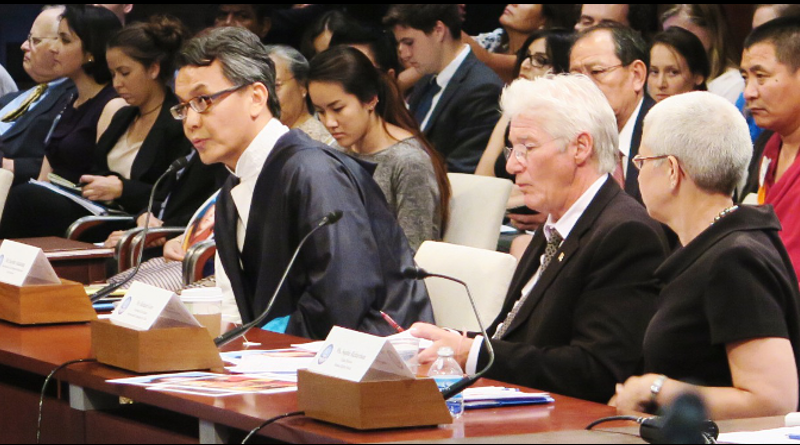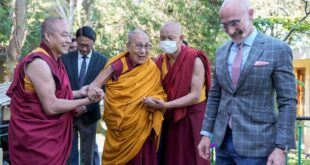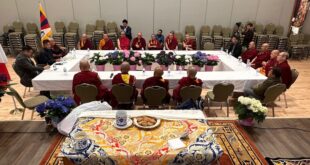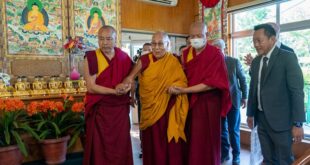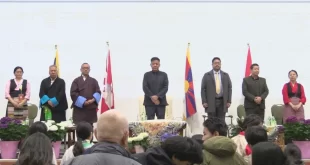Testimony of Representative Kaydor Aukatsang at the US Congress’ Tom Lantos Human Rights Commission Hearing on Tibet & China: Searching for a New Way Forward held on July 14, 2015 in Washington, D.C.
Mr. Chairman:
Thank you for inviting me to testify before your committee. The late Tom Lantos was a steadfast friend of the Tibetan people and a passionate visionary who prioritized the issue of Tibet and transformed it into an important concern for the United States Congress. I want to thank you, Co-Chairs McGovern and Pitts, in particular, for carrying on the work of the late Tom Lantos and for your strong commitment to the Tibetan issue. Your decision to hold this hearing clearly demonstrates your care and concern for Tibet and the Tibetan people. I also want to thank the esteemed members of the Commission for their support and participation.
Mr. Chairman, I was by His Holiness the Dalai Lama’s side during his recent visit to Dallas, Orange County and New York. The visit was organized to celebrate His Holiness’ 80th birthday. I’m pleased to inform you that His Holiness at 80 is still strong, active and tirelessly promoting his message of oneness of humanity, compassion, preservation of Tibet’s Buddhist culture and environment, and a world free of violence. On behalf of His Holiness and the Tibetan people, I would like to express my deep gratitude for the outpouring of support and positive messages that we received from members of Congress on His Holiness’ 80th birthday.
Mr. Chairman, I, also, want to express my deep sadness over the recent death of Tenzin Delek Rimpoche, the well-known Tibetan human rights activist who was serving a twenty-year sentence for charges Rinpoche has always denied. I want to especially thank you Chairman McGovern for your active support in calling for the release of Tenzin Delek Rinpoche on medical parole. Tenzin Delek Rinpoche’s case exhibits the strong Tibetan spirit that no amount of Chinese repression can crush.
For many Tibet evokes images of monks in crimson robes, towering mountains powdered with snow and the smiling face of His Holiness the Dalai Lama. However, the reality of the situation in Tibet is not nearly as beautiful. For over fifty years, Tibet has been under the harsh rule of China. On July 10, Sonam Tobgyal, a 26-year-old Tibetan monk set himself on fire in Kyegudo, Tibet. With this latest self-immolation, at least 141 Tibetans have self-immolated in protest against the Chinese government and its hardline policies since 2009.
Instead of investigating the conditions compelling Tibetans to take extreme measures such as self immolation and redressing its flawed policies, the Chinese government continues its policies of political repression, cultural assimilation, social discrimination, economic marginalization and environmental destruction in Tibet. The policies of the Chinese government have created an environment of profound mistrust and have deeply alienated Tibetans.
Today, I would like to focus my remarks on the Tibetan leadership’s Middle Way Approach to securing genuine autonomy for Tibetans, and the upcoming electoral process for electing the Sikyong, the Tibetan political leader, and the election of other Tibetan leaders.
The Middle Way Approach for Genuine Autonomy for the Tibetan People (“Umaylam” in Tibetan) is a policy conceived by His Holiness the Dalai Lama in 1974 to engage the Chinese government in dialogue and find a peaceful way to protect the unique Tibetan culture and identity. It is a policy that was adopted democratically through a series of discussions held over many decades by the Central Tibetan Administration (CTA) and the Tibetan people. It is a win-win proposition, which straddles the middle path between the status quo and independence – one that categorically rejects the present repressive and colonial policies of the Chinese government towards the Tibetan people while not seeking separation from the People’s Republic of China.
To this day, His Holiness the Dalai Lama remains steadfast in his endorsement of this approach as a realistic and pragmatic solution to the grave and now urgent problems faced by Tibetans in Tibet. The policy’s first accomplishment came with the establishment of direct contact between Dharamsala and Beijing when Deng Xiaoping said in 1979 that, “apart from independence, all issues can be discussed.” Four fact-finding delegations visited Tibet from 1979-1985. Two exploratory delegations from Dharamsala met the highest Chinese leadership in Beijing in 1982 and 1984, and there were official contacts between Dharamsala and Beijing until August 1993.
Since 1987, His Holiness the Dalai Lama has presented the Middle Way Approach in a range of forums around world – including the U.S. Congress and the European Parliament – hoping to once again draw the Chinese leadership into discussions. Dialogue resumed in earnest in 2002, and has led to a total of nine rounds of talks. During the 7th round of talks in 2008 – the year in which unprecedented and widespread protests erupted across Tibet – the Chinese government asked the Tibetan leadership to put in writing the nature of the autonomy it sought. The Memorandum on Genuine Autonomy for the Tibetan People was presented during the 8th round of talks in 2008.
The Chinese government expressed a number of concerns and objections to the Memorandum. To address these, during the 9th and last round of talks in January 2010 the Tibetan leadership presented the Note on the Memorandum on Genuine Autonomy for the Tibetan People. The Memorandum and the Note elaborate how genuine autonomy for the Tibetan people would operate within the framework of the People’s Republic of China: its constitution, sovereignty and territorial integrity, the hierarchy and authority of the Chinese Central Government. The Note further addresses specific concerns raised by the Chinese government in respect to the Form of Single Administration; Political, Social and Economic systems; Public Security; Regulation of Population Migration; Language; and Religion.
Under the Middle Way Approach, Tibetans are seeking a form of self-governance, which would allow them to meet their basic needs but not challenge the unity and stability of the People’s Republic of China. They are seeking a form of autonomy where Tibetan people share customs and value systems, language, way of life and geography. Uniting them under a single administrative unit would be a more efficient and effective form of governance than the existing structure where Tibetans are divided into the so called Tibet Autonomous Region (TAR) and neighboring provinces with a Chinese majority, namely, Qinghai, Sichuan, Gansu and Yunnan.
The Chinese authorities have claimed that it is the Tibetan leadership’s intention to expel “all Chinese” from Tibetan areas. In fact, the Memorandum clearly articulates that when it states, “our intention is not to expel non-Tibetans. Our concern is the induced movement of primarily Han, but also some other nationalities, into many Tibetan areas, which in turn marginalizes the native Tibetan population.” The Memorandum calls for the Tibetan areas to have a Tibetan majority for the preservation and promotion of the unique Tibetan identity. The Tibetan population in the People’s Republic of China is estimated at 6.2 million (6th National Population Census of PRC), which is approximately 0.47% of China’s total population.
A Tibetan regional administration would govern the protection and promotion of the 11 Basic Needs of Tibetans, which encompasses the following: language, culture, religion, education, environmental protection, utilization of natural resources, economic development and trade, public health, public security, regulation on population migration, and cultural, educational and religious exchanges with other countries. This proposal is consistent with both the National Regional Autonomy Law and the Constitution of the People’s Republic of China.
In 2011 His Holiness the Dalai Lama transferred his political responsibilities to the elected Tibetan leadership – the Central Tibetan Administration (CTA) under the leadership of the Sikyong, the democratically elected Tibetan political leader. As stated in the Memorandum, His Holiness has made it clear on numerous occasions that he will not hold any political position in Tibet. As symbol of Tibetan unity and identity, he is a beacon of hope for the Tibetan people. Tibetan people place their hope in his spiritual leadership as the person most trusted with and capable of bringing about a peaceful resolution to the situation inside Tibet. As a Tibetan, he remains deeply committed to lending whatever support is needed to reach a resolution to the current impasse and remains a staunch and unwavering advocate of the Middle Way Approach.
The Tibetan leadership believes the Middle Way Approach is the most viable solution to the current urgent situation inside Tibet. It is also the approach which has enjoyed the strongest international support. Many national governments have officially stated their support for dialogue between the envoys of His Holiness the Dalai Lama and representatives of the Chinese leadership, including the U.S., E.U., Britain, France, Germany, Australia and New Zealand. In the past three years alone, resolutions, motions and statements of support for dialogue have been passed in several parliaments across the world including the U.S., E.U, France, Italy, Japan, Australia, Brazil amongst others.
The Middle Way Approach has also gained strong support from the Chinese community especially Chinese intellectuals and artists such as Noble Laureate Liu Xiaobo, Wang Lixiong, Zhang Boshu and Ran Yunfei. In 2012, 82 Chinese NGOs based in 15 countries sent a petition to the United Nations, EU and various foreign governments and parliaments exhorting them to “urge the Chinese government to start negotiations as soon as possible.”
The Middle Way Approach has also been supported by a number of Nobel Peace Laureates including Archbishop Desmond Tutu of South Africa, Elie Wiesel and Jody Williams of the U.S., Lech Walesa of Poland, Shirin Ebadi of Iran, and several other laureates. In 2012, 12 Nobel Peace Laureates wrote an open letter to Chinese President Hu Jintao, strongly urging the Chinese government to seize the opportunity for meaningful dialogue with His Holiness the Dalai Lama.
To put the Middle Way Approach into effect, numerous global leaders have called for dialogue including several U.S. Presidents. After President Obama’s meeting with His Holiness on July 16, 2011 and February 21, 2014, the White House applauded “the Dalai Lama’s commitment to non-violence and dialogue with China and pursuit of the Middle Way Approach,” and encouraged “direct dialogue to resolve the long-standing differences”, saying “that a dialogue that produces results would be positive for China and Tibetans.”
Lastly, prominent leaders inside Tibet have supported the Middle Way Approach including the late Panchen Lama who openly expressed support for the policy. The late Ngapo Ngawang Jigme, a former minister of the Tibetan government in Tibet, urged the Chinese government to implement regional autonomy in Tibet as promised in its 17-Point Agreement. The late Baba Phuntsok Wangyal, a senior Tibetan official of the Chinese Communist Party, stated that “the Dalai Lama’s Middle Way Approach of seeking only a meaningful autonomy for Tibet rather than independence, is an expression of the great responsibility he takes in giving serious thoughts over the fundamental interests, future and fate of Tibet and Tibetans as a whole…and it is a thinking based on reality and foresight.”
The Tibetan leadership is seeking the support of the Chinese community and the wider international community to encourage the Chinese government to resume dialogue in a spirit of reconciliation, keeping in mind the many benefits to both sides that would stem from genuine autonomy.
The Tibetan leadership believes the Chinese Government can no longer defend its current counter productive policy towards Tibetans in Tibet. The Tibetan people must be granted a genuine say in their own affairs in order for them to live in harmony with basic rights and with dignity. Through the Middle Way Approach, the People’s Republic of China can ensure regional peace and stability. Internationally, it also stands to gain by improving its image in the minds and hearts of people around the world. The Middle Way Approach is a mutually beneficial proposition that can serve as a model for resolving other conflicts in the world. By melding dialogue, nonviolence and compromise the Middle Way Approach creates lasting peace and satisfaction for all parties involved.
However, there has been no dialogue with the Chinese since 2010. Despite this, the Tibetan leadership remains steadfast in its commitment to the Middle Way Approach and to finding a lasting solution through dialogue between the envoys of His Holiness the Dalai Lama and the representatives of the Chinese leadership.
Besides the Middle Way Approach, another lasting gift and legacy of His Holiness the great 14th Dalai Lama is his contribution to deepening promotion of democracy. Here Tibetans have benefited greatly from living in India, the greatest democracy of the world. India has not only been a generous host for Tibetans, but many of our democratic practices and reforms have been taken from India. For this we are most grateful to the government and people of India.
Upon arriving in exile in India in 1959, His Holiness established the Central Tibetan Administration (CTA) and entrusted it with the responsibility of rehabilitating Tibetan refugees through education and cultural preservation while sustaining the Tibetan freedom movement. The democratic reforms that His Holiness had long wanted to initiate in Tibet, which was thwarted by the Chinese, became possible in exile.
As a way to transition into a democratic future for Tibet, His Holiness advised the Tibetan people to elect their own representatives by introducing a new way of governance, one that prioritizes the needs of Tibet and of the Tibetan people above all else. On September 2nd of 1960, the Tibetan parliament in exile, then called the Commission of Tibetan People’s Deputies, was inaugurated. This historic date is observed by the Tibetan exile community as Tibetan Democracy Day.
On March 10, 1963 His Holiness promulgated a Tibetan constitution. He also made structural changes to the governmental institutions and the way in which civil servants serving under the CTA are appointed. The term of the elected parliamentarians was set at three years, and it was also decided that there should be an elected Chairman and a Vice Chairman of the Parliament.
On June 14, 1991, The Constitution Redrafting Committee drafted the Charter of the Tibetans in Exile, which serves as the supreme law governing the functions of the CTA. It was then reviewed and adopted by the Tibetan Parliament-in-Exile. Based on the spirit of the UN Universal Declaration of Human Rights, the Charter guarantees to all Tibetans equality before the law and enjoyment of rights and freedom without discrimination on the basis of sex, religion, race, language and social origin. It provides for a clear separation of power among the three organs of the administration: judiciary, legislature and executive.
His Holiness had faith in the Tibetan people to establish a democratic system of government. Although this experimental stage of democracy was difficult in the beginning, a stable structure has been gradually established. Today, the CTA has three independent branches of the Executive (Kashag), Legislature (Chitue) and the Judiciary, along with the three autonomous departments comprised of the Election Commission, Office of Auditor General and the Public Service Commission. The Kashag oversees the departments of Religion and Culture, Home, Health, Information and International Relations, Finance, Education and Security. There is great deal of transparency and proper checks and balances in place to ensure that the CTA remains free of corruption and abuse.
In 2001, His Holiness encouraged the Tibetan Parliament to amend the charter and allow for the direct election of the Kalon Tripa (later renamed ‘Sikyong’), the Chief Executive of the CTA and the Political Leader, by the Tibetan people. The first directly elected Kalon Tripa was Venerable Samdhong Rinpoche who was elected on August 20, 2001 and reelected for another five-year term in 2006.
The Tibetan charter limits an individual serving in the office of the Kalon Tripa to two terms of five years each. In an open field that drew a large number of candidates for the March 2011 Kalon Tripa elections, Dr. Lobsang Sangay polled 55 percent votes in the 2011 elections and became the second popularly-elected Kalon Tripa
Prior to 2011, the Kalon Tripa position was subordinate to the office of His Holiness the Dalai Lama. However, His Holiness made a historic announcement on March 10, 2011 where he announced that he would formally relinquish his political leadership in the exiled Tibetan administration to the elected leader of the CTA led by the Kalon Tripa. This decision was intended to strengthen the democratic structure of the Tibetan movement. “My desire to devolve authority has nothing to do with a wish to shirk responsibility. It is to benefit Tibetans in the long run,” His Holiness said.
On September 20, 2012, the 15th Tibetan Parliament-in-Exile unanimously voted to amend the Tibetan charter and change the title of Kalon Tripa to Sikyong which translates to “political leader” as distinct from “spiritual leader.”
Sikyong Dr. Lobsang Sangay led 14th Kashag’s (Executive Cabinet) and the current 15th Tibetan Parliament’s five year term will expire this fall. The Election Commission of the Central Tibetan Administration announced on June 10, 2015 the dates for the primary and general elections of the Sikyong of the 15th Kashag and members of the 16th Tibetan Parliament-in-Exile. The preliminary election is slated for October 18, 2015 and
March 20, 2016.
The 2016 general election will elect the fourth directly-elected Sikyong (earlier Kalon Tripa) and the 16th Tibetan Parliament-in-Exile. The 16th Tibetan Parliament-in-Exile will be composed of 45 members with ten representatives each from the three traditional Tibetan provinces; two representatives each from the four major schools of Tibetan Buddhism and Bon religion, two representatives from North and South America, two representatives from Europe and Africa, and one representative from Australia and Asia (excluding India, Nepal and Bhutan).
Mr. Chairman and honorable members of the Committee, let me again reiterate the full commitment of His Holiness the Dalai Lama and the Tibetan leadership to a peaceful, negotiated settlement to the Tibet question within the framework of the People’s Republic of China, and to further deepening the democratic reforms initiated by His Holiness.
In closing, I want to thank you and the US Congress for your continued support. It is important that the United States, the leading nation of the free world, speaks up for the plight of the Tibetan and other oppressed people around the world.
